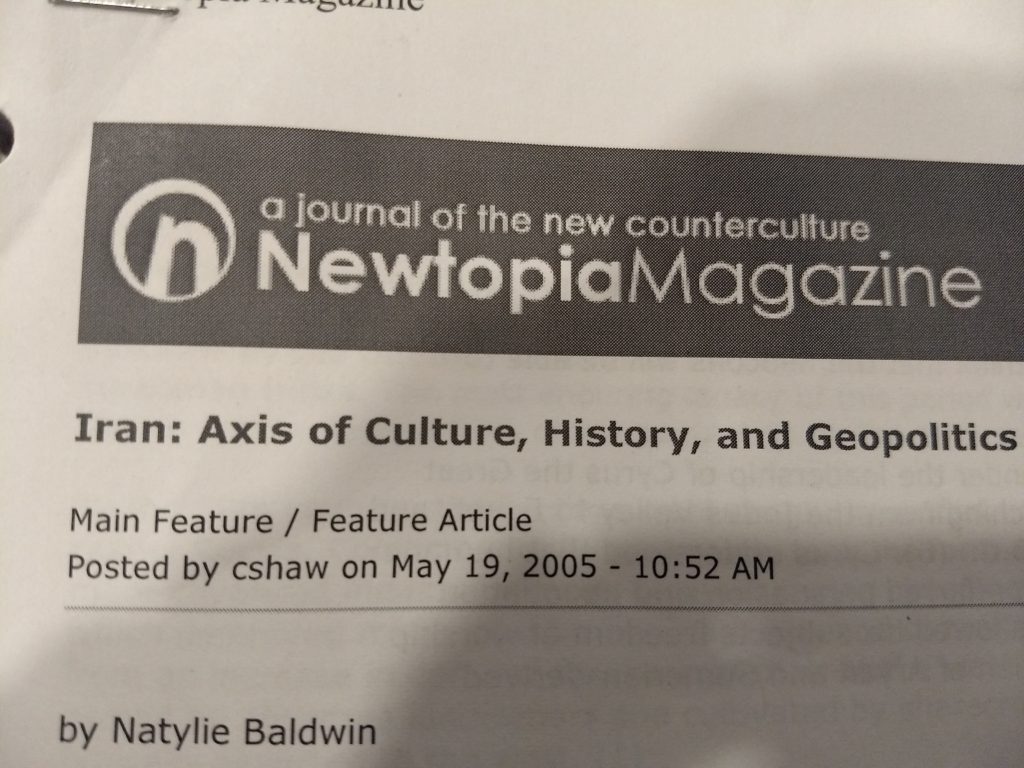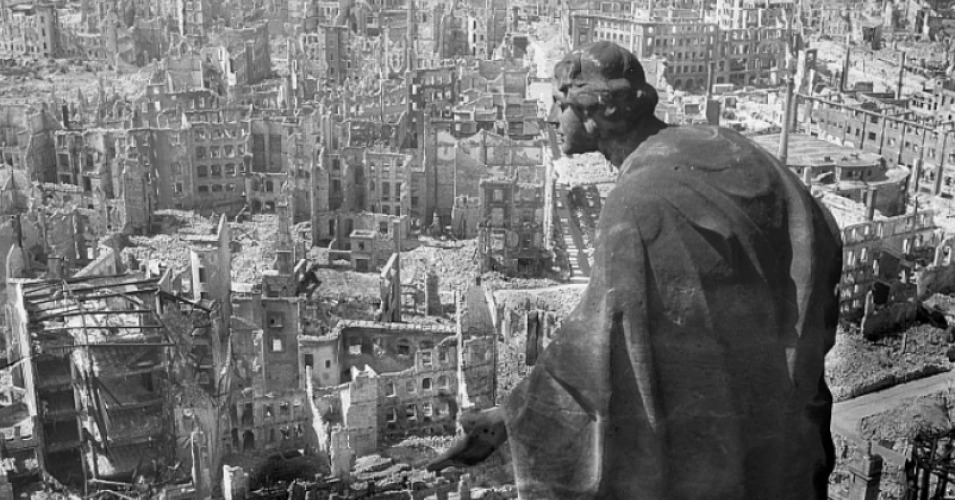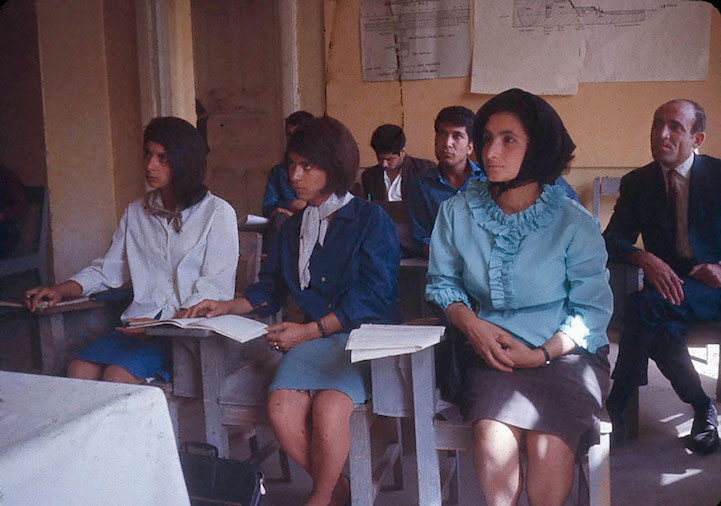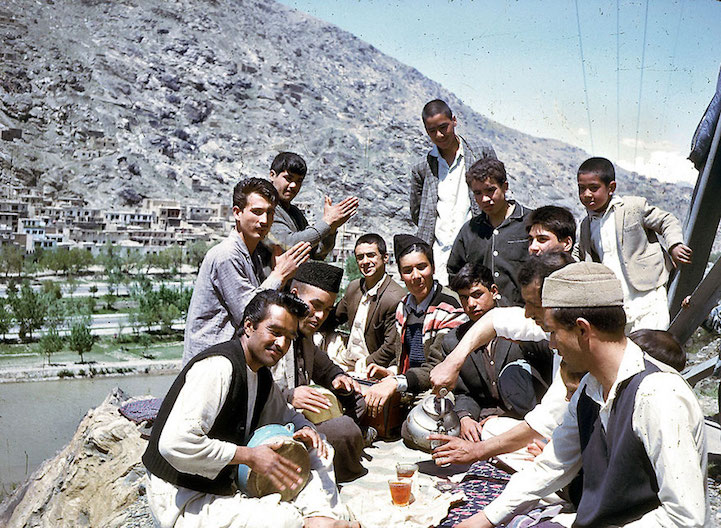
This is an article I wrote in May of 2005 about Iran. It was originally published by Newtopia Magazine, which is now defunct. I’m publishing it here so that it has a home on the web and for whatever value readers may still derive from it 15 years later. – Natylie
The strong independent spirit of the Iranian people stems from a long history of imperial powers exerting their hegemony directly or using the nation as a pawn in a series of rivalries, namely the Great Game between Russian and Britain in the 19th century, the Cold War in the 20th, and the newly intensified petro-politics of the 21st. Americans would be well-advised to look into the Iranian past if they think that the Neocons will be able to succeed where other imperialists have failed.
When I first viewed photos of the breathtaking images of the detailed rock carvings at the tomb of Xerxes near the ancient Persian capital of Persepolis, along with the Zoroastrian fire temple, I wondered how many in the U.S. had any idea about this part of the rich and complex narrative of a civilization that in ancient times reached a cultural level comparable to that of Greece, Rome or Egypt. Within the psychological landscape of most Americans, Iran is a distant place filled with strident Khomeini worshippers and women in chadors, remembered most for a frenzied band of zealots who held the U.S. embassy staff hostage over some little understood animosity towards the shah – a man that the U.S. media, throughout most of his brutal reign, depicted with warmth (1).
More recently, anxious post-911 Americans were told by their president that Iran belongs to an ominous triumvirate of evil nations. Seymour Hersh (2) and Scott Ritter (3) both claim to have scuttlebutt from inside sources that the U.S. is planning a military attack on Iran.
Many analysts point out that such an attack would not be feasible due to a shortage of U.S. military personnel, Iran’s possession of the dreaded Sunburn missile(4), and the slim chance that Vladimir Putin would simply stand by while a neighbor with such geo-strategic significance is invaded. Therefore, there is speculation that the Bush administration’s saber-rattling is just bluster to get Iran to take negotiations more seriously regarding its nuclear program.
This might be reassuring except that the past words and deeds of Neoconservatives do not indicate that they have been blessed with an overabundance of rationality or a sense of limitations. Added to this volatile mix is the very real likelihood that Iran is seeking to develop nuclear weapons as what it logically perceives to be the only possible deterrent to a declared hostile superpower that militarily occupies Iraq to the west and Afghanistan to the east, with numerous bases in the Caspian region to the north. Iranians across the political spectrum support such a nuclear program in the interests of maintaining their independence as a nation free of foreign domination (5).
The strong independent spirit of the Iranian people stems from a long history of imperial powers exerting their hegemony directly or using the nation as a pawn in a series of rivalries, namely the Great Game between Russian and Britain in the 19th century, the Cold War in the 20th, and the newly intensified petro-politics of the 21st. Americans would be well-advised to look into the Iranian past if they think that the Neocons will be able to succeed where other imperialists have failed.
The ancient Persian civilization reached its peak under the leadership of Cyrus the Great who united the various tribes and ethnicities stretching back from the Indus Valley to Egypt, and chose Persepolis as his capital in the 5th century B.C. (6). Cyrus understood that humane rule was the simplest way to maintain loyalty. He preferred persuasion and negotiation over force, never humiliated the vanquished, and allowed his subjects freedom of worship. Cyrus also had genuine respect for the amalgamation of Aryan and Sumerian-derived influences that was Persian culture.
Owing to Persia’s unique geographical realities, tribes within the Iranian plateau were historically vulnerable to invasions and had developed loose confederations for protection. However, experience soon demonstrated that a strong and charismatic leader was needed to bridge internal rivalries. Moreover, in the transition from nomadism to agricultural settlements, a spiritual philosophy called Zoroastrianism had emerged in the 6th century B.C. as an ethical guide for resource distribution (6).
Zoroastrianism stressed compliance with a code of just behavior, the origin of the just ruler concept that has been such a strong force throughout Iranian history up to the present. It is this tradition that made the Persians receptive to Islam with its strong emphasis on social justice hundreds of years later (6).
More authoritarian leaders like Xerxes and Darius were less effective at holding alliances. By the time of Darius III, the areas proximate to Greece had shed any loyalty to the Persian Empire, which contributed to Alexander the Great’s defeat of the Persians in battle.
By 208 A.D., with the Iranian plateau’s north and south reunited, the tradition of Cyrus was revived in the Sassanian dynasty. Persian culture enjoyed a renaissance with the emergence of such cultural trademarks as the architectural dome and vault, carpet-making and miniature painting. But Persia again descended into political and spiritual stagnation when the Sassanians sanctioned religion as a means of consolidating power (6).
By the 7th century, the Persians were ready to embrace the message of Muhammad but considered their sophisticated culture superior to that of the tribal Arabs. The Arab incursion occurred at a time of major controversy within Islam regarding the legitimate successor to Muhammad. Ali, a blood relative to Muhammad as well as his first convert, was passed over in favor of Abu Bakr. After Bakr’s death, a series of successors from the aristocratic Umayyad class conquered territory by force while Ali, a quiet and humble preacher of justice and egalitarianism, developed a significant following (Shia Ali). After Ali’s death, his son, Hussein, continued to advocate the Shia viewpoint and confronted a massive Umayyad army with only 72, all duly massacred (6) (7). The anniversary of his martyrdom is still mourned with profound emotion through passion plays (ta’ziyeh), mostly among the popular classes, as it resonates with the grief and injustice many have experienced (1).
Other invasions occurred in later centuries, the most devastating of which was carried out by the Mongols, notorious for their organized butchery. In response to Mongol brutality, Persians retreated into the fatalistic mysticism of the Sufi order, an apolitical group under the tutelage of Safi-al Din of the Safavids renowned for his boundless generosity to the poor. Over the centuries, Sufism was transformed into a political force and gained a following among the tribal Turkomans who mobilized an army in its name. During this time the Persian Empire expanded under a brand of Sufi-influenced Shiism but was eventually defeated by the Ottoman Turks in 1514, taking the northwestern territory inhabited by the Turkoman tribes. The most enduring legacy of this period was the continued spread of Shiism which claimed 95% of the population by the 18th century (6).
By the 19th century, the Persians were caught in conflict between imperial Britain and czarist Russia. Conflicts with Russia mostly took the form of border disputes while Britain, a more advanced industrial power, began dumping cheaply manufactured exports in Persia, which destroyed many local farmers, artisans and bazaaris, although a handful benefited from an increase in demand for raw materials to the west. By century’s end, most land was owned by absentee landowners and cultivated by sharecroppers whose produce was typically exported to the west (1).
The reigning Qajar dynasty. comprised of the shah, his court and regional treasurers, collected revenue mostly from the poor peasant majority. Due to lack of centralized control, the ulama (clergy) provided hospitals, schools and other social infrastructure. Sustained popular agitation resulting from increased government debt to foreign powers, extravagant personal expenditures by the shah and corresponding economic hardships on the majority, led to reform demands from the ulama. The central demand involved the establishment of what would become the Iranian parliament, or Majles.
Subsequent negotiations for drafting a constitution, however, proved problematic.
Secular reformers framed their arguments in terms that the average Persian could not relate to, while the ulama invoked popular religious rhetoric. The resulting constitution only vaguely addressed reforms with any potential to limit the ulama’s influence, and failed to limit the shah’s authority. By 1911, the constitutional movement was dead due to ineffectiveness, desertion by the ulama and the intervention of outside powers (1) (6).
At the end of WWI, most of Iran was under the control of the British. Its economy was in shambles and food scarce while separatist movements flared. A military commander named Reza Khan staged a British backed coup. He focused on building and maintaining a strong army in order to minimize foreign dominance and ensure security. He suppressed rebellions, centralized government control and embarked on an intensive modernization program, reasoning that to compete with and subdue the west, Persia had to emulate its ways. He viewed Islam as an obstacle to modernization, and glorified pre-Islamic Persia. Reza was declared shah in 1925 and took the name Pahlavi. Meanwhile, the ulama fumed under increasing marginalization (1) (6).
The shah’s downfall was precipitated by his support of the Nazis. Britain and Russia demanded that the shah expel the Germans and then marched into Iran, forcing the recalcitrant shah’s abdication and accession of his son, Muhammad Reza Shah. Social and economic discontent deepened due to war-related destruction and Reza Shah’s continued influence in the Majles. Little opportunity for meaningful redress existed, however, as British and American interests dug in for oil (1).
During WWII, Britain had enjoyed monopoly concession rights to Iran’s oil through the Anglo-Iranian Oil Company (AIOC) (1). When Muhammad Mossedeq, a populist leader of the National Front coalition, spearheaded passage of a bill in the majles – which, by this time had weakened the shah’s authority – to nationalize Iran’s oil in 1951, Mossadeq’s popularity soared, leading him to victory as prime minister the following month (8).
With British and American support, Mossadeq was eventually pushed from power and Muhammad Shah reinstalled. The coup likely would have been impossible if Mossadeq had succeeded in taking control of the military (8) (1). Many Iranians still view Mossadeq as a national and democratic hero and wonder what Iran might be like today had he remained in office (9).
With strong U.S. support, the shah’s reign in the 1960’s and 70’s was characterized by a rise in GNP driven by oil, massive corruption, and increased socioeconomic dislocation for most Iranians. Many of the shah’s development policies reflected western methods that were inappropriate to Iran’s conditions but benefited a few Iranian elites and U.S. corporations. The result was mass exodus to urban areas that were largely unprepared for the influx. Urban workers faced inflation, low wages, shortages of essential goods and insufficient productive investment (1).
This period was also marked by evermore repressive political tactics via SAVAK, the shah’s secret police, trained by the CIA and Mossad (1). The brutality of the shah’s Iran by 1976 was described in an Amnesty International report as “[having] the highest rate of death penalties in the world, no valid system of civilian courts and a history of torture which is beyond belief. No country in the world has a worse record in human rights than Iran” (8).
By the late 1970’s, the confluence of economic grievances, extreme political repression and outside influences united the various groups within Iran with the common goal of ousting the shah. These included nationalists, leftists and Islamists, though the Islamists were the only group with limited ability to express opposition (1) (10). The human rights rhetoric of the Carter administration provided some transitory cover for the dissidents who disseminated petitions in Iran in 1977. The shah initially made some minor concessions because he was uncertain as to how serious the U.S. administration was about human rights. He subsequently realized that as long as Iran played ball on oil, the U.S. would sweep human rights issues under the rug (1).
As organized opposition against the shah’s regime reached a critical mass, the State Department began attempts to contact the more moderate elements in order to stave off the possibility of a more stridently anti-U.S. replacement, to little avail (1).
As an Iranian blogger in Tehran known as The Brooding Persian stated, “As revolutions go, the overthrow of the monarchy was relatively painless. But what happened afterwards was a killer. I was enthusiastic about the revolution though didn’t much care for the Ayatollah from day one. I never thought of it as his revolution” (11). Any revolutionary coalition with so many different groups with various perceptions of self-interest will have post-revolution jockeying for power. The group(s) who are the most willing to rout out their competitors with any means necessary are typically the ones who prevail (9).
Ayatollah Khomeini spoke out against Reza Shah in an early book called Secrets Exposed wherein he outlined the blueprint for an Islamic government ruled by mujtahids – or educated members of the clergy just below an ayatollah. To Khomeini the majles was simply an instrument of western imposition and only mujtahids could be trusted to govern with sufficient piousness.
Khomeini’s following increased from 1961 – 1963, during which he renewed criticism against Muhammad Shah’s regime. He was arrested several times and eventually exiled. He subsequently wrote another book, Islamic Government, which expanded on his earlier writings and articulated three points: 1) monarchy is to be unequivocally condemned, 2) legitimate authority comes only from Islamic jurists who interpret the Quran and Traditions (hadith), and 3) Islam must be vigilant against corruption from within and without (1) (7). Of the several influential ayatollahs of the revolution, including Third World Movement anti-colonialist Ali Shariati, Khomeini was the most enduring and extreme.
When the overthrow of the shah had been completed, Khomeini – as the uncompromising revolutionary leader in absentia – was flown into Tehran from Paris to take the reins. Despite promises to National Front leaders in the revolutionary coalition, Khomeini refused to place any democratic language in either the name of the new republic or in the constitution (1). Khomeini forcefully suppressed competing parties, maintained the secret police and cemented his powers by purging universities of all leftists, destroying grassroots workers’ councils, and personally appointing local clergy who led Friday prayers (1).
Afshin Matin-Asgari, a participant in the 1979 revolution, now a professor at Cal State Los Angeles, observed the revolution heading in a troubling direction even before the shah’s overthrow but believes that the shah’s repressive regime is to blame for creating conditions in which only the most reactionary elements could emerge as a viable alternative, “In retrospect, I think the revolution’s balance has been negative [but] that does not mean thinking that the Shah’s regime was a good thing” (12).
Life under Khomeini was one of general economic stagnation and draconian controls on personal behavior, justified by extreme religious interpretation, enforced by fundamentalist vigilantes (1) (9). There were, however, some advancements in the areas of education and health, especially in the provinces. War with Iraq from 1980 to 1988- in which the U.S. sided with Saddam Hussain’s Iraq – unified Iranians and diverted attention away from internal problems.
The end of the war and Khomeini’s death the following year allowed for some debate among the top ulama, though Khomeini’s successor, Ayatollah Khameini, was hardly more liberal. President Rafsanjani followed the wishes of Khameni and implemented more privatization, deregulation and free-trade style policies (1). Frustration among Iranians in general continued to build as many felt that, in addition to a war that had required huge sacrifices, the revolution had not lived up to its promise of justice (10) (11).
In 1997, a burgeoning Reform Movement channeled frustration into action as the Iranian people voted for Muhammad Khatami as president over Khameini’s favored candidate. Khatami was a quiet intellectual who, as cultural minister, had eased censorship and advocated reconciliation between Islam and liberal democracy, the rule of law, political rights for women and minorities, equitable economic development and a moderate foreign policy (14).
Khatami, however, has been limited in what he can accomplish, due mainly to the Khomeinist Guardian Council, consisting of twelve Islamic jurists, six appointed directly by the Supreme Leader and six nominated by a judiciary controlled by the ulama. The Guardian Council has ultimate veto power over any legislation by the majles it deems in conflict with Islam. The Guardian Council can also vet candidates for office and has recently disqualified thousands of reformists from running (13).
The Reform Movement is another complex coalition of left-leaning clerics and various secular progressives. As Iranian economist and self-described anti-imperialist/Marxist/Feminist Simin Royanian points out: “Today’s ‘Democracy and Liberalization’ movement in the jargon of the western powers, especially the U.S. government, means trade and market liberalization” (10).
Iranian political observers have broken down the Reform Movement into six general streams ranging from hard-left – or unionists and revolutionaries, to more right-wing reformers consisting of the upper middle class who favor a top-down free market reform package that protects their gains, along with some political liberalization (14) (15). Many of the reformers do not support economic liberalization policies, but actively support stronger unionization, higher wages and social welfare protections for women and children (10). A student protest at Tehran University that turned violent in June of 2003 was in response to a proposed privatization plan (16).
With the failure of Khatami to implement significant reforms, much of the Iranian population, including reform supporters, is disillusioned. Youth comprise a large percentage of the population and show signs of increasing depression and alienation. Drug use, immediate self-gratification and consumerism are on the rise (1) (17).
Afshin Molavi, an Iranian-American journalist who chronicled his journey through Iran in a 2003 book, Persian Pilgrimages, encountered two recurring complaints: lack of economic opportunities and disgust with archaic religious policies. Many express ambivalent or even positive feeling towards the United States as a result of associating such negative conditions with the Islamic Revolutionary government free of foreign control. In a country where a despised regime espouses rhetoric of the U.S. as the Great Satan, sympathy toward the U.S. is one small expression of defiance (9).
If the U.S. were to attack Iran, however, any supportive sentiments would likely evaporate quickly (5) (11). Iranian human rights attorney and Nobel Peace Prize recipient Shirin Ebadi has argued persuasively how a military intervention would destroy Iran’s gradual march toward greater human rights by rallying newfound support to a regime that will opportunistically clamp down further (18). The point was echoed by Royanian, “When the gates [of reform] opened, there followed a flood, which continues today. If the U.S. intervenes, the gates will close” (10).
The Brooding Persian agreed: “I think what we need here is time and space to map out our own priorities. So my only solution for now is freedom, tolerance and space. Iranian encounters with the west in modern times have been problematic, something to look up to while also being fearful of. The west’s conduct in Iran has been less than exemplary – assorted intrigues and conspiracies and wars and coups. And you can’t reconstruct those memories away. Since a lot of people loath this regime so much, most are willing to forgive and forget…well, until the next round that is” (11).
References:
- Keddie, Nikki R. Modern Iran: Roots and Results of Revolution. Yale University Press. New Haven, CT. 2003.
- “The Coming Wars” by Seymour Hersh. The New Yorker. January 2005.
- “Sleepwalking to Disaster in Iran” by Scott Ritter. Al Jazeera. March 30, 2005.
- “Iran: A Bridge Too Far?” by Frank Gaffney. Information Clearing House. October 26, 2004.
- “The Iran Situation” by Ahmad Sadri and Foaad Khosmood. Zmag. February 20, 2005.
- Mackey, Sandra. The Iranians: Persia, Islam and the Soul of a Nation. Plume/Penguin Publishers. New York, NY. 1998.
- Esposito, John L. Unholy War: Terror in the Name of Islam. Oxford University Press. New York, NY. 2003.
- Blum, William. Killing Hope: U.S. Military and CIA Interventions Since WWII. Common Courage Press. Monroe, ME. 1995.
- Molavi, Afshin. Persian Pilgrimages: Journeys Across Iran. WW Norton and Company. New York, NY. 2003.
- Email correspondence with Simin Royanian, April 4, 2005.
- Email correspondence wit The Brooding Persian, April 10, 2005.
- Email correspondence with Professor Afshin Matin-Asgari, April 25, 2005.
- “Essential Background: Overview of Human Rights Issues in Iran” by Human Rights Watch. January 13, 2005.
- “Protest and Regime Resistance in Iran” by Bijan Khajepour. Middle East Report Online. 12/11/02.
- “The New Landscape of Iranian Politics” by Morad Saghafi. Middle East Report Online. Winter 2004.
- “Iran Protest Rally at Student Dorm Turns Violent.” Payvand’s Iran News. June 13, 2003.
- “Another Link.” The Brooding Persian blog. February 5, 2005.
- “The Human Rights Case Against Attacking Iran” by Shirin Ebadi. The New York Times. 2/8/05.


